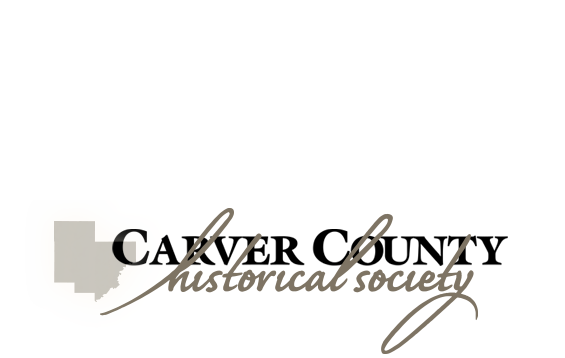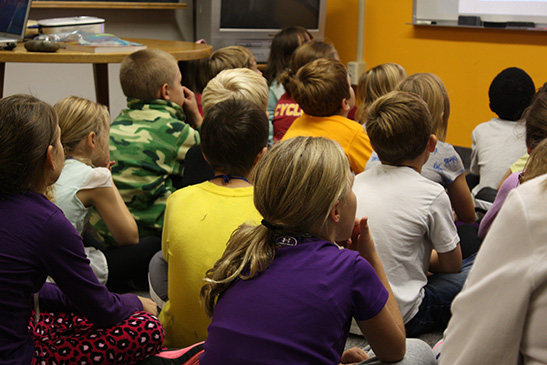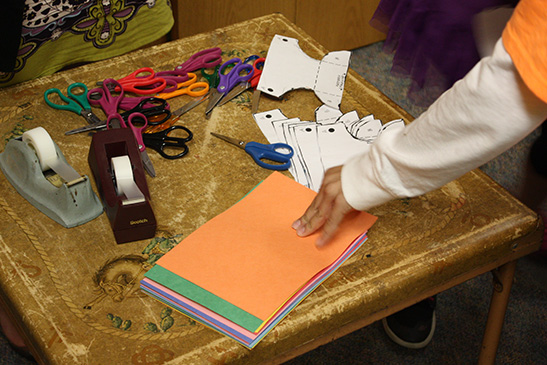School Programs
The Carver County Historical Society is proud to offer a variety of programs for schools and groups of all ages and sizes. Are you looking for a supplement to your classroom lessons or a way to think outside the box? Through the use of artifacts, maps, historical photos, and other primary sources, students learn how national events affect local history. All programs offer a hands-on learning experience for students. Each program offers a creative, cooperative or interactive element at the end, and/or throughout the program.
Scheduling Your Visit
School programs at CCHS are available year-round, Monday through Friday, 8am–4pm and can be booked at the school or at the museum. These programs are also great for Girl and Boy Scout troops, 4-H clubs, home school classes, and other youth group events. CCHS School Programs are FREE to all non-profit and educational groups. Charges apply for having an educator visit your group; call for pricing.
Teachers, you may book down for a lower grade program, but may not book up (i.e. grade 3 could book Homesteading but not Renewable Energy).
To check availability, please contact Jayna Hulleman at (952) 442-4234 or jhulleman@carvercountymn.gov.
Museum visits are available Monday through Friday, 8am–4pm. Museum visits are FREE, though donations are greatly appreciated. Visits to the museum last approximately one hour and include a scavenger hunt tour of the museum.
For more information about our voluntary compliance with Minnesota state education standards, please call Wendy Biorn, Curator of Education and Exhibits, at (952) 442-4234.
Available School Programs/Traveling Programs
All Grades: One Room Schoolhouse
School sure has changed in the past 150 years! A Carver County teacher from the past will help your students discover what life was like in a pioneer schoolhouse. Students will learn how going to school has changed over the last century by following 19th-century classroom rules and participating in reading, recitation, handwriting, and arithmetic lessons similar to those taught in the original one room schools. Grades 1–3: 45 minutes; Grades 4&5: 60 minutes
Northern Lights: Chapter 7
Preschool: Mysteries in History
Students will explore their historical curiosities as they engage questioning and reasoning skills to solve artifact mysteries. What is it made from? What does it smell like? Does it look like something we use today? Is it an ice skate or a vegetable chopper? 30 minutes
Kindergarten: How Artifacts Tell Stories
Learn how historians and educators interpret objects. What can objects teach us? What stories do they tell? Using questions and imagination, imagine the stories of its previous owners. 30–45 minutes
Northern Lights: Chapters 1 & 2
Kindergarten: Mysteries in History
Your students will use artifacts and inquiry-based learning to help solve a “mystery in history.” How do we know what we know about the past? Students will explore their historical curiosities as they engage questioning and reasoning skills to solve artifact mysteries. What is it made from? What does it smell like? Does it look like something we use today? Is it an ice skate or a vegetable chopper? 30 minutes
Northern Lights: Chapter 1
Grades K–4: Life In a Lumber Camp
In this program, students will learn about the history of the lumber industry and its place in the history of the settlement of the West. Students will also discover what life was like in a lumber camp, putting themselves into the shoes of workers and/or learning the tall tales told by lumberjacks through stories about Paul Bunyan. 45 minutes
Northern Lights: Chapters 11 & 13
Grade 1: Putting Your Life in a Box
Students will help pack an immigrant trunk. They must choose what items to bring with them to America and what to leave behind – not everything will fit in the trunk! Students are asked to think about what types of things immigrants would want to bring with them when they move to a new country where they have never been before. This activity is designed to encourage students to think about what it is like to leave a place you have always called home for a new one in a strange country. 30–45 minutes
Northern Lights: Chapters 7 & 20
Follow-up activity: Coming to America interactive story
Post-visit activity: Trunk Diagram: What would you bring?
Grades 1–2: History Exploration 101
There are many ways to study the past, and in this lesson, we will explore just a few. Students will learn about primary and secondary sources, what an artifact can teach us, and the importance of oral history. Students will conduct mock interviews with classmates. 45 minutes
Northern Lights: Chapters 1 & 2
Grade 2: Dakota & Ojibwe Daily Life
The Dakota and the Ojibwe played a key role in the history of our state and are still prominent today. Through dance, diet, and more students will come to understand how different Dakota and Ojibwe life in the past was to life today. There is a choice of 2 activities: mokuks or dream-catchers. 45 minutes
Northern Lights: Chapters 3 & 4
Grade 2: Down on the Farm
Can you imagine life 150 years ago? Without Wii, without electric toasters, without even an indoor toilet? A CCHS staff member will help your class try their hand at homesteading, discover aspects of pioneer life (from growing the crops to going to the bathroom), and even churn their own butter! Students will get a chance to handle and use all of the artifacts. This program is designed to explore the differences between family life today and yesterday, and to let students discover what hard work it was to farm and keep house in Carver County during the 1880s. 45 minutes
Northern Lights: Chapter 10
Grades 2–4, 5–6: Can You Hear Me Now?
It is time to explore how technology has changed and evolved over time. From the first computers, telephones and music players to modern ones, explore how technology has advanced, shrunk in size and become easier to use. Students will come to understand a computer’s language through a binary alphabet activity. Older students will explore how robots understand directions given to them. 45 minutes
Northern Lights: Chapter 119
Grades 2–4: Early Explorers
Students will learn about the first explorers that set foot in the area of Carver County, including Jonathan Carver and Father Hennepin. They will also learn a bit about the everyday life and trials of explorers. A mapmaking activity is included to introduce students to some of the challenges early explorers faced when mapping a new area. 45 minutes
Northern Lights: Chapter 5
Grades 2–4: Inventors and Inventions
Students will explore five major inventions that changed the way people lived: the threshing machine, steamship, telephone, electricity and the train. Students will consider the work that goes into developing new inventions and how different their lives would be without commonplace items. Students will imagine how future inventions will impact the world of their children and grandchildren while looking at what some futurists living in 1900 thought the year 2000 would look like. 45 minutes
Grades 2–6: STEM – Motion and Flight (airplanes 2–3, parachutes 4–6)
Birds and how they fly have long fascinated humans. For thousands of years, humans have attempted to fly themselves, with mixed results. Come explore these many attempts and learn the science behind how flight works. For older students, more detail into scientific theory and law will be given. Each grade will conduct experiments to test their understanding of motion and flight. 60 minutes
Grade 3: History Detectives: Historians 101, Anthropology 101, Archaeology 101
With 3rd graders now studying ancient civilizations, this series focuses on building historical inquiry skills. Students will explore the world of historians and how to craft timelines; immerse themselves in thinking as an anthropologist and studying culture; and get ready to dig and interpret as archaeologists through a mock dig. Each lesson 45 minutes
Northern Lights: Chapters 1 & 2
Grade 3: Ghost Towns
Not all ghost towns are in the Wild West! Whether or not a town survives depends on four main factors: people, transportation, organization, and natural resources. Students will learn about why some towns survived while others did not, and how civic duty and economic choice played a role in shaping the future of these communities by looking at examples of lost communities right here in Carver County. 45 minutes
Northern Lights: Chapter 11
Grade 4: Exploring the Great Northwest
Students will learn about the fur trade in Minnesota by actually living it! Students will experience Minnesota wilderness firsthand as they pretend to travel with French Canadian voyageurs of the 18th century to a small fur trading post just south of Carver, called Little Rapids. Your students will also be introduced to the dynamic of Native American-trader relations and how Europeans and Native Americans worked together or conflicted in the industry. This is a fun way to explore Minnesota history through pictures, song, and re-enactment! 45-60 minutes
Northern Lights: Chapter 5
Grades 4–7: People of MN
Contemplate the history of Minnesota through the immigrant groups who made MN what it is today. From the first settlers to the 21st century— why choose MN? What challenges do they face? How have these cultures influenced MN? This program will include a choice of 4 crafts— from Asia, Hmong story cloths; from India, rangolis; from Africa, Ashante adinkra cloth; and from Mexico, god’s eyes or "ojo de dios". 45–60 minutes
Northern Lights: Chapters 1, 7, 12 & 20
Grade 5: Can You Dig It?
Even though Carver County has only been around for a little over 150 years, the history of the area dates back thousands of years. The stories of these people are woven in the evidence found in the earth. In this program, students will learn about Native Americans in Carver County by studying bone tools, stone artifacts, and ceramics. Your students will also get the chance to dig through trash to discover how the archaeological record is made! 60 minutes
Northern Lights: Chapter 2
Grades 5–6: Lucie Aubrec: Outwitting the Gestapo
Although American women were active in the workforce and other home-front activities during WWII, Lucie Aubrec lived and worked in France during the Nazi occupation. This program details her participation in the European Resistance. 45–60 minutes
Northern Lights: Chapter 16
Grades 5–7: Renewable Energy
Learn the history and uses of hydroelectric power, wind power and solar power. Using engineering/ inquiry-based learning skills and critical thinking skills, assemble one of three usable solar, wind, or water machines. 60–90 minutes, 1–2 sessions
Northern Lights: Chapter 19
Grades 5–7: STEM – Dust Bowl: Drought & Water
Drought is a condition caused not only by natural conditions, but also by the effects of man on the environment. Students will explore the causes and effects of the Dustbowl during the Great Depression through images and personal accounts. A 2-part science project studying the impact of farming practices on soil moisture and erosion will follow. 60 minutes (2 sessions or borrow kit)
Northern Lights: Chapter 15
Grade 6: Rosie the Riveter
Explore life in Carver County during World War II as we meet Rosie, a mother and wife of an army infantryman who takes a job in a munitions box factory during the war. Students will experience her life during the war through words, photos, posters, and objects and will discover the impact WWII had on the homefront. 40–50 minutes
Northern Lights: Chapter 16
Grade 6: Marching Barefoot
Minnesota was still a young state when the Civil War began, but it quickly became embroiled in one of the country's most contentious and devastating wars. From Fort Snelling to Carver County, no other state in the Union sent a higher percentage of their male population to war. Students will understand the important role that Minnesota played in the war by engaging map and reasoning skills and using primary sources (Carver County Civil War diaries) to get a firsthand look at Minnesota life during the 1860. 50 minutes
Northern Lights: Chapters 8 & 9
Grades 6 and up: A Snapshot of Carver County
Students will explore ancient Carver County history, Jonathan Carver, and the creation and end of the fur trade. The class will then be flipped, as students themselves will study assigned cities or townships and present that history to the class in order to demonstrate knowledge gained and used. Through these activities, the students will leave the class with a glimpse of the history of Carver County. 45–60 minutes
Grades 6 and up: From Forests to Farms to Towns: An Aerial View of Carver County
Carver County is a growing community that is easily identifiable by pictures from the air. A good way to visually picture growth is through aerial views of towns in order to easily spot population and economic growth and other minute changes that take place through the years. The 11 major cities in Carver County have supplied aerial views from 1937, 1991 and 2013. By viewing these, students will be able to spot and record differences and changes and even predict what the future may hold by viewing trends over the years. 45–60 minutes
Grades 6–8: We Are All Equal: Civil and Human Rights
What is a basic human right? How are these rights abused around the world? Students will explore universal human rights, the Universal Declaration of Human Rights, and interpret images of rights being enjoyed, denied, or people protesting to get a right. This will tie-in with a discussion of the Civil rights Movement, civil rights leaders, and human rights issues in today’s world. 60 minutes
Northern Lights: Chapter 18
Grades 6–8: The Red Scare: In Hollywood, the Media and at Home
Explore the fear and unrest of the 1950’s and the Red Scare. Meet key figures, view propaganda and political cartoons, and understand censorship and Communism. Students will compare growing up in the era of fear and hysteria to others in U.S. history and draw parallels. 60 minutes
Northern Lights: Chapter 17
Grades 6–8: The Noble Experiment: Prohibition
Prohibition was a unique time in American history, what many call the "noble experiment". President Hoover called it "the great social and economic experiment, noble in motive and far-reaching in purpose". It was a time of mobsters, flappers, bootlegging and speakeasies. Students will explore the history of Prohibition and key groups and leaders. They will explore the interesting facts and consequences of this decade. They will get creative as they create their own unique propaganda posters for or against the issue. 60 minutes
Northern Lights: Chapter 15
Grades 6–8: Brother, Can You Spare a Dime?: Hope in Hard Times
The Great Depression was the harshest economic crisis the United States has faced in modern industrial times. Millions lost their livelihood and lived in shantytowns, banks closed across the country, and President Hoover called it a "passing crisis". Americans needed hope to escape their troubles. They got that hope in FDR and his New Deal and through escape with free or cheap entertainment. Students will explore the idea of escapism, and take on the roles of families affected by this crisis and facing tough choices. 60 minutes
Northern Lights: Chapter 15
Grades 4–5 and up: STEM – "The Golden Buckle of the Dairy Belt": From Apples to Alfalfa
Carver County is a predominantly rural, agricultural county, though that continues to changes as our cities develop. Learning about our county’s valuable contributions to agriculture and horticulture will help to preserve this farming legacy for future generations. In this lesson, students will explore alfalfa and apples and the innovators who labored to make them grow through harsh Minnesota winters right here in Carver County. Students will understand the science behind cross-pollination, apple breeding, and grafting. 45–60 minutes
Northern Lights: Chapter 10
Grades 4–8 or 9–12: How to Do Oral History
Oral history is a tool for collecting and preserving history. It allows people to tell their stories as they talk, prompted by questions from an interviewer. Oral history is easily lost — if someone passes away or loses their memory, all their stories and recollections are gone too. In the program, learn how to select an elder to interview, how to ask appropriate questions, and how to use digital voice recorders. Also learn some "Oral History Do's and Don'ts". 45–90 minutes
Northern Lights: Chapter 2



